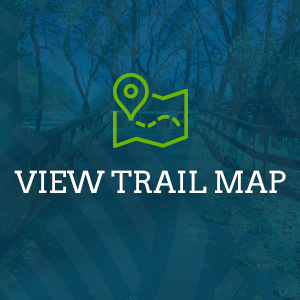Independence. Innovation. Awareness.
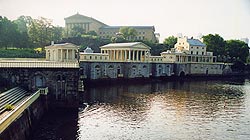 The Schuylkill River Greenways National Heritage Area is the birthplace of the movements that shaped the nation, fueled its growth, and reclaimed its future. It was along the banks of this river and its tributaries that the American, Industrial, and Environmental Revolutions were born. Explore the stories, visit the places, and experience the region’s vitality by visiting the Schuylkill River Greenways. America’s past and its future start here.
The Schuylkill River Greenways National Heritage Area is the birthplace of the movements that shaped the nation, fueled its growth, and reclaimed its future. It was along the banks of this river and its tributaries that the American, Industrial, and Environmental Revolutions were born. Explore the stories, visit the places, and experience the region’s vitality by visiting the Schuylkill River Greenways. America’s past and its future start here.
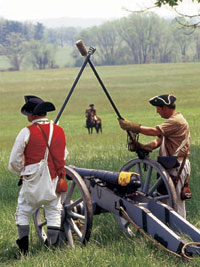
Valley Forge National Historical Park (credit: Valley Forge Convention & Visitors Bureau)
The battle for the independence of America began and turned upon events within the Schuylkill River Heritage Area. In Philadelphia a group of men took bold steps and did something that had never been done before: declared their freedom from the most powerful nation on earth. At Germantown, Paoli, Fort Mifflin and Brandywine, the patriot army fought difficult battles with the British. At Valley Forge, a war-torn and weary group of men suffered through a grueling winter and emerged in spring as a well disciplined army. The farms and furnaces to the north and west provided much needed food and supplies to the patriot cause. American history turned here.
Politics and culture
By the mid 1700s Philadelphia had grown to be the largest English-speaking city in the world outside of London. It was also one of the most ethnically diverse cities, and the mix of cultures, values, and religions made Philadelphia the cultural, social, and political center of the North American colonies. This mix of people and ideas created an environment for talking about radical ideas that was unparalleled in other North American cities at the time. When anger over taxation and the policies of the British Parliament reached a fevered pitch in the early 1770s, delegates from each of the 13 colonies met in Philadelphia. Here they could debate their issues far more freely than would have been possible in Boston or Charleston. Those places were viewed as being too radical or conservative in their views. Philadelphia presented a unique opportunity for these men to gather and share their hopes, dreams, and fears about declaring their freedom. The mix of politics and culture in Philadelphia also allowed for the free expression of ideas and beliefs by the citizenry. English-born Thomas Paine arrived in Philadelphia in 1774 with the assistance of Benjamin Franklin. An outspoken critic of Parliament and its policies, Paine embraced the patriot cause and published Common Sense in 1776. The pamphlet was one of the most convincing cases for independence made up to that point, and helped convince the colonists to support the war effort. Following the Revolution, the task of establishing a new government was debated in Philadelphia. The Constitutional Convention met in the State House and toiled over the proper way to govern these newly independent states. The Constitution was signed in the Pennsylvania State House in 1787, and Pennsylvania became the second state to ratify the document later that same year. Philadelphia was established as the first capitol of the United States, a role it served until 1800. Montgomery County born Frederick Augustus Muhlenberg became the first Speaker of the House of Representatives.
Battles and encampments
The Revolutionary War arrived in Southeastern Pennsylvania in earnest the summer of 1777. Prior to that time the impact of the war had been purely financial and political as the Continental Congress continued to meet in the Pennsylvania State House (Independence Hall) and the financial resources of the region's citizens were tapped to support the war effort. However, a contingent of British troops landed in Maryland in August 1777 and began their march northward. Washington and his generals suffered three crushing defeats at Brandywine, Paoli, and Germantown over the next two months, and the British took control of Philadelphia in late September.
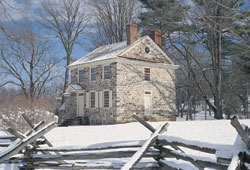
Washington's Headquarters at Valley Forge NHP (credit: Valley Forge Convention & Visitors Bureau)
As battles between patriot General Horatio Gates and Sir John Burgoyne raged in upstate New York, Washington and his army feverishly worked to defend and reclaim Pennsylvania and New Jersey. In November, British General William Howe launched an offensive against patriot-controlled Fort Mifflin at the confluence of the Schuylkill and Delaware Rivers. The lower Delaware was a critical supply route for the British and as long as Fort Mifflin was under Washington's control, Philadelphia was closed to British supply ships. For six weeks this tiny, incomplete island fort was laid under siege. From November 10 through 15, 1777, it is estimated that the British fired 1000 canon ball, shot & shell into the Fort every 20 minutes. Of the 406 men garrisoned, close to 250 were either killed or wounded. Howe and his army conquered the Fort, but the service of these men delayed the supplies that the British needed. If it was not for the men who served in Fort Mifflin, the British Army would have had their supplies earlier and General Washington's Army could have been destroyed. Following the defeat at Fort Mifflin, Washington moved his army up the Schuylkill to prepare for the winter. The tired and tattered group arrived in the tiny village outside the Valley Forge in mid-December. The army set up camp on the bluffs overlooking the Schuylkill River and waited out the long and unusually cold winter. As spring approached the largely untrained and ill-equipped militia began drilling and training under the direction of Prussian Baron Friedrich von Steuben. It was here that they learned to become an army and to fight the British on their own terms.
Supplying the cause
The concentration of battles, encampments, and political influence in Pennsylvania meant that food, weapons, and other supplies were in high demand. The fertile fields of Berks, Chester, and Montgomery Counties were pressed into service to meet the needs of the cause. The Schuylkill River Heritage Area was home to over 50 iron forges and furnaces in 1776, more than all the other colonies combined. While most produced household items like pots, nails, and hinges, several, including Hopewell Furnace, cast cannon and ammunition.
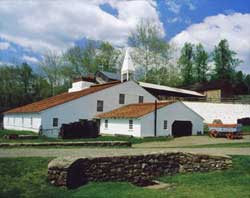
Hopewell Furnace National Historic Site
The American Revolution was largely a private cause fought on the public's behalf. The colonial assemblies supplied militia and some cash, but there was no unified system for the collection of funds or supplying of troops. Many wealthy individuals, particularly merchants, responded by fronting cash and supplies to the Continental Congress, who in turn distributed them to the Army. Robert Morris, a Philadelphia merchant was among the principal financiers of the American Revolution. Like many elite Philadelphians, Morris lived in the city during the fall, winter, and spring, but retreated to the country during the oppressive summers. Morris made his home at Lemon Hill on the banks of the Schuylkill River. Of course, not everyone in the region was supportive of the Patriot cause. The Pennsylvania legislature arrested many pacifist Quakers for their lack of support and relocated them to Virginia. Residents in the backcountry, particularly predominantly English Chester County, vehemently opposed the war, which caused considerable difficulties in obtaining supplies and moving troops.
Industrialism took hold along the Schuylkill River and its tributaries very early in the nation's history. The abundant natural resources and the fast moving waters of the river and its tributaries fueled the nation's economic engine for centuries. Mines, factories, mills and forges sprung up across the region and helped make Southeastern Pennsylvania an industrial powerhouse and worldwide leader in the Industrial Revolution.
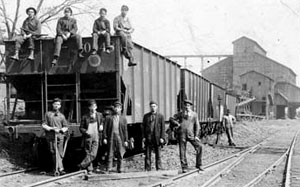
credit: Historical Society of Schuylkill County
Dozens of factories, forges, mills, and mines dotted the landscape and gave rise to technological innovations that would change the course of human history. Transportation networks traversed the landscape to deliver the goods these industrial giants produced to markets. Drawn by the abundant employment opportunities and the promise of a new life, immigrants from around the globe came to the Schuylkill River Heritage Area to find work and establish communities. These groups wove a rich tapestry of languages, foods, music, and arts up and down the river that made the Schuylkill a vibrant, diverse, and culturally significant region.
A wealth of resources
The unique geography and geology of the Appalachian Mountains and the Piedmont meant that Southeastern Pennsylvania was blessed with a number of fast moving water courses, abundant forests, and a variety of underground minerals. These resources attracted entrepreneurs and innovators who sought to harness the earth for economic and societal gain to the Schuylkill River Heritage Area. The rugged limestone and granite peaks of the Kittatiny Ridge of the Appalachians cross the river in Schuylkill County and contained the nation's largest supply of anthracite coal within their folds. As the mountains flattened into a series of rolling hills and valleys on their way eastward, the limestone flattened into a thick slab that extended westward toward the Susquehanna. The limestone served to make the soil in Berks, Montgomery, and Chester Counties among the most fertile lands east of the Mississippi. The stone also provided settlers with a durable and abundant building material for their homes and barns. Iron ore, jasper, ochre, and other minerals were also found in abundance beneath the surface.
The waters that coursed out of the mountains and through the valleys powered the mills and factories that made these resources ready for consumption and then transported them to market in Philadelphia. The lush valleys of the Piedmont gradually turned into coastline and marshlands along the Delaware River in Philadelphia where wharves, docks, and other facilities waited to transport goods to markets around the world.
Technological innovation
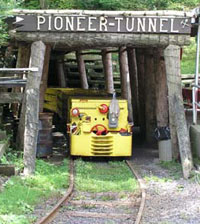
Pioneer Tunnel Coal Mine and Steam Train, Ashland
The diversity of the landscape and the variety of natural resources made the Schuylkill River Heritage Area ripe for the development of several important industries. The presence of iron ore helped make the region the most productive iron producer of all of the colonies. At the time of the American Revolution there were more ironworks in Pennsylvania than in all of the other colonies combined, and nearly 2/3 of them were in Berks, Chester, and Montgomery Counties.
The discovery of anthracite coal in Schuylkill County in 1790 led to the development of one of the world's greatest industries and changed the way individuals heated their homes and factories powered their facilities. The iron and coal industries found a happy marriage with the development of steel technology and led to the large factory complexes in places like Reading, Birdsboro, Phoenixville, Conshohocken, and Philadelphia. At the turn of the 20th century Philadelphia was known as the "Workshop of the World" and was home to the Baldwin Locomotive Works, Stetson Hats, and a variety of knitting mills, breweries, and steel mills. Textile mills, tanneries, ship yards, and refineries and numerous other industries all used the river and its tributaries as a source of power.
Getting the goods to market
The success of industry depended almost entirely upon the ability of manufacturers to transport the products to market. The Schuylkill River served as the spine of a complex transportation network that extended from Philadelphia to Schuylkill County and that helped to usher in industrial innovation and growth of global significance. The discovery of coal prompted a number of Philadelphia merchants to establish the Schuylkill Navigation Company in 1815 to undertake construction of one of the earliest canal and river navigation systems in the country. The Schuylkill Canal transported coal downstream and finished goods to upstream communities. The Canal was surpassed in the mid 1800s by railroads that could move goods and people over land faster and cheaper than by water. The Philadelphia & Reading Railroad was established in 1834 to haul coal from Schuylkill County via Reading and onto Philadelphia. In the 1870s, the P & R was the largest corporation in the world. By 1924 the railroad was composed of 24 separate lines and was renamed the Reading Company. The Reading went bankrupt in 1971, but today the Blue Mountain, Reading & Northern Railroad operates on a part of the original alignment in Berks and Schuylkill Counties, making it one of the oldest operating railroad alignments in the world. The Pennsylvania Railroad, also based in Philadelphia operated an extensive network along the Schuylkill, and sections of the Schuylkill Valley Branch became the 140-mile long Schuylkill River Trail that runs from Philadelphia to Pottsville.
It's the people that matter
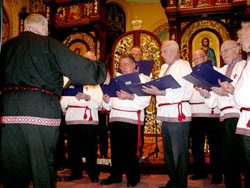
Byzantine Male Choir, Schuylkill County (credit: Carrie Kline)
The real success of the Industrial Revolution in the Schuylkill River Heritage Area should be attributed to the men and women who labored in its factories and mines. Immigrants from around the globe flooded the docks in Philadelphia and New York during the 19th and 20th centuries hoping to find work in the region's burgeoning mills and coal fields. In the anthracite region, German and Welsh miners helped to open the earliest mines and were quickly followed by Scots-Irish, Italians, Slovaks, Lithuanians, Greeks and others in record numbers. Each group spoke a different language, ate different foods, worshiped a different god, and yet coexisted in the same communities and shared similar experiences. This diversity was mirrored in communities up and down the river and today millions of Americans can trace their ancestral roots to the Schuylkill River Heritage Area.
The roots of the nation's environmental movement can be traced to the people, places, and events of the Schuylkill River Heritage Area. It was here that naturalists like John Bartram and John Audubon began to document their surroundings in an attempt to understand our world. In the 19th-century, the City of Philadelphia took a pioneering step by purchasing land along the Schuylkill River with the sole intention of protecting the river as a source of drinking water. Nearly a century later the Commonwealth of Pennsylvania and the United States government embarked on the nation's first and largest environmental cleanup project on the Schuylkill River. Our nation's conservation ethics and environmental responsibility were born here.
Understanding Our World
The 18th century was a time of incredible curiosity and discovery about the natural world. In Sweden, a young medical student name Carl Linnaeus became fascinated with the variety and multitude of plants around him. He set out on a life\'s quest to catalog and categorize not only plants, but animals, and other forms of life as well. His classification system became the scientific standard that is still in use today.
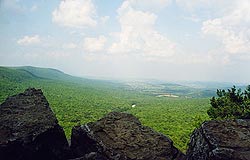
Hawk Mountain Overlook
Linnaeus influenced his colleagues around the world in a significant way, particularly in the American colonies. John Bartram, a Quaker farmer born on the outskirts of Philadelphia became intensely interested in plants and botany at a young age and set about collecting, studying, and propagating plants from around the world at his farm along the lower Schuylkill. King George III appointed Bartram Royal Botanist in 1765, a position he held until the American Revolution. Bartram is considered to be the nation's first true botanist and among the first to study and propagate native plants. His garden contained over 200 species of plants, some of which still survive today. Both John Bartram and his son William traveled extensively throughout North America. John traveled north through Montgomery and Berks Counties regularly. He was among the first to explore the Kittatinny Ridge and the areas surrounding Hawk Mountain. The elder Bartram also served as Conrad Weiser's guide on his 1751 expedition to meet the Iroquois Nations in Albany, NY at the height of the French and Indian War. William is well known for his trips into the swamps of Georgia and Florida, and his journals, which he published as the book Travels. In the late 18th century the family of Caribbean born Frenchman John James Audubon settled into a large estate near the confluence of the Perkiomen Creek and the Schuylkill River. The Audubon family stayed at Mill Grove for only a short time, but retained ownership of the property, which was rich with mineral deposits and fertile soil. John James returned in 1803 as a young man to oversee and manage the farming and mining operations. It was at Mill Grove that Audubon first began to explore the natural world, and developed his interest in and love of birds. He spent hours traversing the forests and creeks in and around Montgomery County seeking, hunting, collecting, and sketching wildlife. It was along the Schuylkill and its tributaries that Audubon first learned to "see" nature and began painting nature as it had never been painted before. Audubon's life work, The Birds of America, changed the way the world viewed birds and their environment. He awakened in the public an appreciation of the beauty and majesty of birds and mammals of all types, a move that lead a few dedicated individuals to speak openly about the need to protect our environment, not only for humanity, but for our animal counterparts.
Protecting our environment
The Industrial Age of the 19th century was certainly not an atmosphere that we would consider conservation-friendly. The nation and its economy were growing by leaps and bounds and using every available resource to do so. Rivers were dammed, forests were cut, and minerals were extracted at an astounding rate. By the mid-19th century coal operations in Schuylkill County had turned the Schuylkill River into an inky black mess. As villages and hamlets along the river grew into cities and towns, they increasingly turned their back on the river as its quality decreased and powerful industries harnessed it to power their operations. The river became an open sewer, as communities diverted their industrial and residential waste into the water.
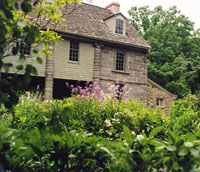
Historic Bartram's Garden, Philadelphia (credit: Greg Matosky)
The problem with this "out of sight, out of mind" approach was that there is always someone downstream, and in this case, the City of Philadelphia was on the receiving end of the river and all that it carried with it. Philadelphia, the largest city in North America at the time, relied upon the Schuylkill for its drinking water. The Fairmount Water Works, constructed in 1812, drew water out of the river and supplied it to the city\'s citizens through a network of pipes. Philadelphia's water system was a North American first, and an engineering marvel around the world. The picturesque Neo-Classical buildings of the Water Works quickly became the most reproduced image of the 19th century. Concerned with the protection of the Schuylkill as a source of drinking water, the City and the State chartered the Fairmount Park Commission in 1867 for the purposes of acquiring land along the river to prevent industrial development and pollution. This is among the first recorded instances of a government purchasing open space as a protective measure. Fairmount Park went on to acquire over 9,000 acres of land along the Schuylkill, Wissahickon, and other water courses in the City. The Park remains one of the largest urban parks in the nation today. In the late 1920s bird hunting was at an all time high along the Kittatinny Ridge. Thousands of raptors fell every year as hunters lined the ridge during migration season. Concerned with the rapid population decline of these important birds, New York born conservationist Rosalie Edge leased 1,400 acres on the border between Berks and Schuylkill Counties in 1934 and the next year opened the lands to the public for recreation, not hunting. The locals called the place "Hawk Mountain" and the mountaintop preserve quickly became a popular visitor attraction. Hawk Mountain was the world's first refuge for birds of prey and quickly grew into a worldwide leader in bird and habitat conservation.
Reclaiming our river
At the conclusion of World War II, Philadelphia and all of southeastern Pennsylvania remained among the most densely populated parts of America. The Schuylkill River, while still a major source of drinking water for millions of people, was more polluted than ever. The river was virtually lifeless, with barren banks, and few if, any fish and plant life to speak of. Chief among the problems was the coal silt that accumulated in the river as a result of the washing and sorting activities in the coal fields at the headwaters.
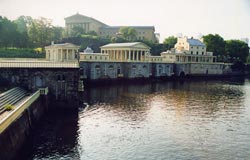
Fairmount Water Works, Philadelphia (credit: Greg Matosky)
In order to rejuvenate the river and reclaim it as a viable source of water, the State of Pennsylvania and the United States government began the Schuylkill River project in 1947. The Commonwealth made use of the dams and land holdings of the defunct Schuylkill Navigation Company that it had acquired in the 1930s to construct large basins to settle the coal out of the water. The river was diverted into 26 80-150 acre basins along its length beginning in lower Schuylkill County on the south side of the Kittatinny Ridge. Once filled, the water in the basins was allowed to stand until all of the silt and sediment had settled to the bottom. The water was allowed to seep slowly back into the river, and once empty was allowed to fill again. After several feet of debris had accumulated, dredging equipment was brought in and the coal dust was reclaimed for use in a variety of products including charcoal briquettes for backyard BBQs. The Schuylkill River project was the first major environmental clean up effort undertaken by a government agency in the United States. At its peak, it was also the largest operation of its kind in the world. Reclamation efforts continue to this day, with products like river stones being harvested between Schuylkill and Montgomery Counties. Many of the basins were allowed to revert to native wildlife habitat after reclamation efforts ceased. Black Rock Wildlife Sanctuary in Phoenixville, and Kernsville Basin near Hamburg are two such sanctuaries open to the public. These basins provide outstanding birding, hiking, and picnicking opportunities. The Commonwealth of Pennsylvania designated the Schuylkill as the state's first Scenic River in 1972.
